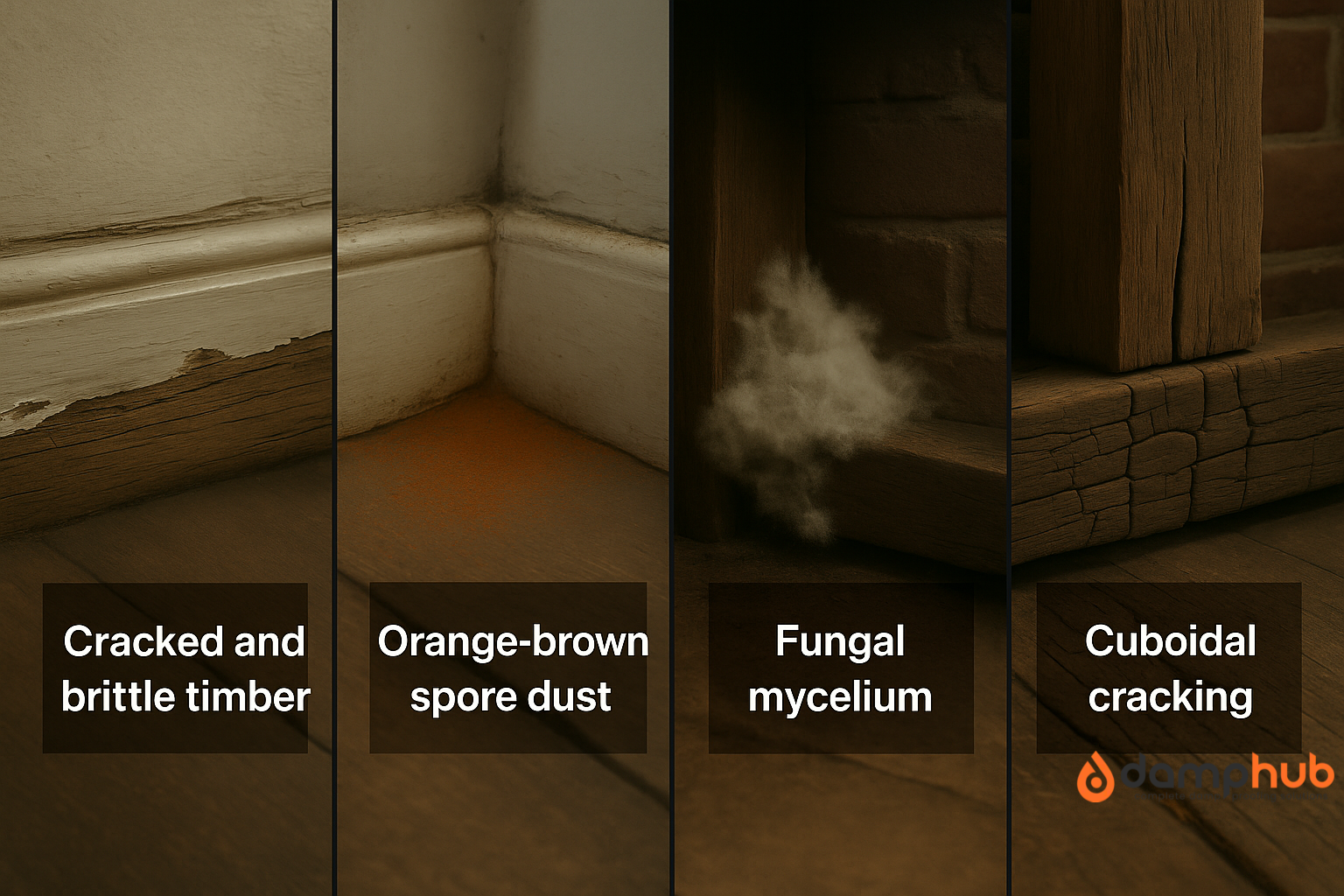
Key Takeaway – Dry Rot
- ✓ It won’t go away on its own — you have to fix the cause and treat it properly.
- ✓ It spreads fast and hides well — often behind walls or under floors.
- ✓ Moisture is always to blame — leaks, damp, poor airflow.
- ✓ Early signs are easy to miss — soft wood, musty smell, orange dust.
- ✓ Half-treatments don’t work — you need to stop the cause or it comes back.
Dry rot is a type of fungal decay that breaks down wood from the inside, leaving it brittle, hollow, and unsafe. It’s caused by excess moisture and poor ventilation, and it can spread further than you’d think.
The trouble is, most dry rot symptoms don’t look serious at first. Many homeowners put it down to age or damp until real damage sets in. But identifying it early makes all the difference.
In this post, we’ll explain what dry rot symptoms mean, what causes them, and how to tell if it’s time to get a proper inspection.
What Are the Early Signs of Dry Rot in a House?
Spotting dry rot symptoms early is the best chance you’ve got of avoiding serious damage and expensive dry rot repair work. Here’s what to watch for:
- Paint that bubbles, peels, or flakes without obvious damp nearby
- Timber floors or door frames that suddenly feel springy or soft
- A lingering damp smell — earthy, mouldy, but not always wet
- Hairline cracks appearing in the wood grain, especially near the skirting
- Orange-brown dust gathering in corners or along timber
These dry rot early signs are subtle, and that’s what makes them dangerous. The fungus doesn’t need soaked wood, just timber with a high enough moisture content, often from poor ventilation, plumbing leaks, or trapped humidity.
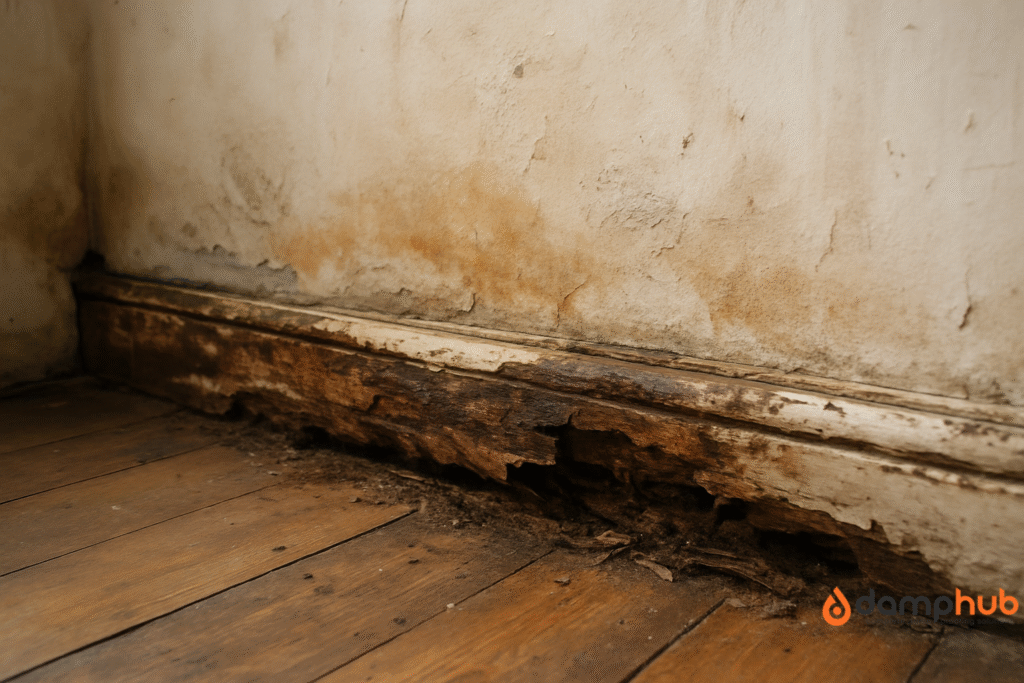
What do dry rot symptoms actually mean?
Most people spot dry rot symptoms without realising what they’re looking at. But each dry rot symptom tells a clear story, and once you know what they mean, it’s easier to grasp just how serious the problem might be.
- Dry rot symptoms signal that moisture has settled in and ventilation has failed — creating the perfect conditions for the fungus to take hold and spread.
- Crumbly wood, flaking paint or distorted skirting boards mean the fungus is already inside — breaking down the timber’s structure from within.
- A strong, musty smell means fungal growth is active, not just lingering damp. The rot is feeding — and it won’t stop on its own.
- Orange spores around timber joints show the fungus is mature and ready to spread, sending out millions of tiny particles to colonise new areas.
- Visible symptoms often appear late, meaning the rot may have already reached hidden floorboards, joists or wall plates.
- Without proper treatment, dry rot continues to grow behind walls and under floors, weakening the property’s structure with every passing week.
What is the Main Cause of Dry Rot??
Dry rot symptoms aren’t just bad luck; they have clear causes, and most of them are avoidable. The fungus that causes it, Serpula lacrymans, feeds on damp timber.
The moisture doesn’t have to be extreme; even 20% wood moisture content can be enough to kick things off.
Here’s what typically sets it off:
- Leaking pipes or overflows in hidden spaces
- Poor ventilation, especially under suspended timber floors
- Rainwater ingress from faulty gutters or roof leaks
- Blocked air bricks or sealed-up vents
- Rising damp that’s left untreated for years
Once timber gets wet and stays wet, the fungus takes hold. It spreads through walls, plaster, and brickwork in search of more timber to feed on. That’s what makes it so destructive; it doesn’t just stay where it starts.
Helpful article: A Guide to Damp and Timber Reports

What are the four stages of dry rot?
Dry rot symptoms don’t start with a mushroom or crumble your skirting boards overnight. It goes through four stages, each one telling you how far it’s spread and how urgent it’s become.
The stages are as follows:
1. Spore Dust
Dry rot begins invisibly. The fungus lives as microscopic spores, floating around in the air. When they settle on wood, you’ll often see a rusty-orange dust, especially in damp corners or underfloor voids.
At this stage, the spores are harmless unless there’s moisture. But once they find it, they activate.
🟠 Good to Know
- ✓ Spores are always present indoors. It’s the high moisture that makes them dangerous.
2. Hyphae
Once the spores wake up, they send out thin, white strands called hyphae. These stretch into the timber, searching for food and breaking down the wood’s structure bit by bit.
This stage happens out of sight inside the timber, so by the time you notice anything on the surface, it’s already progressing.
💡 Pro Tip
- ✓ Pro Tip: Hyphae often look like soft cobwebs or cotton wool where the rot is active.
3. Mycelium
The hyphae join together to form a dense, fluffy mass called mycelium, usually grey or white, with a soft, felt-like texture. This is when dry rot becomes destructive.
Mycelium spreads aggressively across surfaces, including brick and plaster, seeking more wood to colonise. You might spot it behind skirting boards, under floorboards, or in basements.
💬 Trust Signal
- ✓ A proper surveyor will confirm this with a moisture reading and timber probe, not just a visual guess.
4. Fruiting Body
The last stage of dry rot symptoms is the most visible, a thick, fleshy, rust-coloured lump. This is the fruiting body (or sporophore), and it’s how the rot reproduces.
It sends out thousands of new spores into the air. If the environment is still damp and poorly ventilated, the cycle starts again somewhere else in your home.
❗ Why It Matters
- ✓ Seeing a fruiting body means the rot has been active for a while, and the internal damage could be significant.
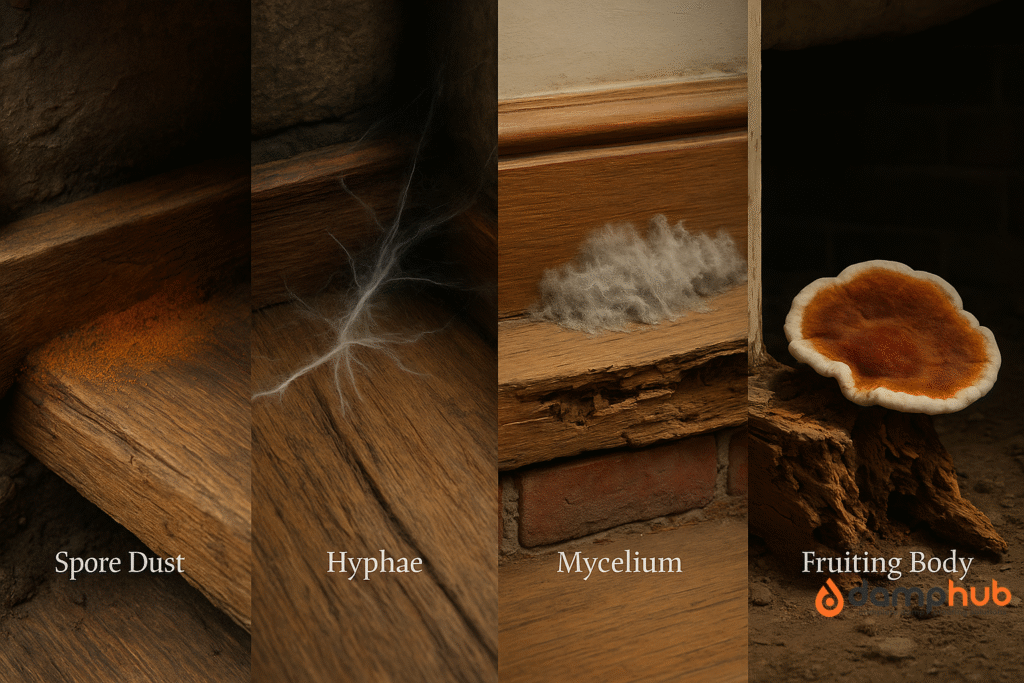
What is the Best Way to Repair Dry Rot?
There’s no shortcut here. Proper dry rot symptoms treatment involves three steps, and skipping any one of them usually means it comes back.
- Find and stop the moisture source: You can’t treat dry rot without drying out the timber. That means fixing leaks, unblocking air bricks, or tackling rising damp first.
- Strip back the affected area: All infected timber, plaster, and even brickwork needs to be removed. Sometimes that includes hidden joists or flooring that still looks intact.
- Apply a fungicidal treatment: This is where a dry rot treatment spray or paste comes in. Professional-grade solutions soak into the masonry and remaining timber, stopping spores from regrowing.
- Replace Timber and Other Materials: Once the area is dry and treated, replace all removed sections with treated timber or rot-resistant wood. In key areas like subfloors or support beams, this is vital for structural safety.
- Improve Ventilation and Airflow: Dry rot thrives in damp, stagnant air. Improve ventilation by installing air bricks, adding vents, or opening up sealed areas. This helps keep moisture levels down and prevents future fungal growth.
- Monitor for Recurrence: After treatment, keep an eye on the area. Use moisture meters to check damp levels and look out for early dry rot signs, like a musty smell, cracking wood, or paint bubbling.
Helpful resource: What Percentage Damp Is Acceptable In Walls?
How to Treat Dry Rot at Home? (And When Not to)
You can treat small patches of dry rot yourself, like a bit of damaged skirting where you’ve already dried the area out.
But here’s the truth: once it’s spread behind plaster or into subfloors, this isn’t a DIY job.
Still, want to give it a go? Here’s how to treat dry rot at home:
- Dry the area fully — use dehumidifiers and ventilation.
- Cut out all affected wood, plus 500mm beyond any visible damage.
- Clean the masonry, brushing off spores.
- Apply fungicidal spray generously across wood and brick.
- Replace with treated timber, not regular wood.
But if you’re seeing white strands, large spore dust patches, or fruiting bodies, call someone in. It’s not just about fixing the visible dry rot symptoms; it’s about cutting it off at the source.
👉 Our full guide: Dry Rot Treatment: How to Identify and Eliminate the Problem (UK Guide)
What’s the Best Dry Rot Treatment Spray?
Most professional surveyors won’t just grab a spray off the shelf; they’ll use an industrial-strength fungicide designed to kill dry rot deep in walls and wood fibres.
That said, if you’re tackling very early-stage dry rot symptoms (and you’ve stopped the moisture source), some of the most commonly used dry rot treatment sprays in the UK include:
- Ronseal Wet Rot Wood Hardener (for very minor, localised use)

🔦 Just Note
- ✓ Sprays won’t solve anything unless the wood is dry and the source of damp has been fixed. In many cases, especially with structural timber, a surveyor’s advice is well worth the fee.
How Much Does Dry Rot Repair Cost in the UK?
This depends entirely on how far it’s gone. For small patches in a floorboard or windowsill, you might spend £150–£300. But if it’s made its way into structural timber or subfloors, the price climbs fast.
| Type of Work | Estimated Cost |
|---|---|
| Survey and diagnosis | £150–£300 |
| Localised treatment | £300–£800 |
| Full dry rot repair (walls, floors, timber) | £1,500–£6,000+ |
| Ventilation and damp work (to stop recurrence) | £500–£2,000 |
👉 Related article: Who Should Pay for a Damp and Timber Report?
Can Dry Rot Come Back After Treatment?
Yes, and it often does if the underlying issue isn’t sorted. Dry rot spores are incredibly hardy. All it takes is a bit of moisture and the right temperature, and it’s back.
That’s why dry rot treatment isn’t just about spraying a fungicide. Proper ventilation, permanent damp proofing, and treated timber are what stop it returning.
Also, always check hidden areas after any treatment; under stairs, behind skirtings, or under floors. If it’s made it there once, it’ll try again.
💡 Pro Tip
- ✓ Don’t just go by the smell, it’s tempting to think that if the musty scent fades, the dry rot is gone. But dry rot can linger out of sight, especially in brick or untreated timber. Always check with a torch and a flathead screwdriver.
Wet Rot vs Dry Rot: How Can You Tell the Difference?
Wet rot and dry rot can look similar, especially early on, but the treatment and urgency are very different. Here’s how to tell them apart:
Wet Rot vs Dry Rot
Side-by-Side Feature Comparison
| Feature | Wet Rot | Dry Rot |
|---|---|---|
| Moisture | Needs very high moisture levels | Can start at lower moisture |
| Spread | Stays near moisture source | Can spread far through masonry |
| Appearance | Dark, softened wood | Brittle, cracked, often lighter |
| Growths | Black fungi, sometimes slimy | Orange spore dust, white strands |
| Smell | Damp and musty | Earthy and sweet-sour |
⚠️ Key Thing to Remember
- ✓ Wet rot damages only where it’s wet, while dry rot travels. That’s why dry rot repair often involves more than just fixing one beam — you may need to cut back entire sections of floor or wall to stop it in its tracks.
Which is Worse, Wet or Dry Rot?
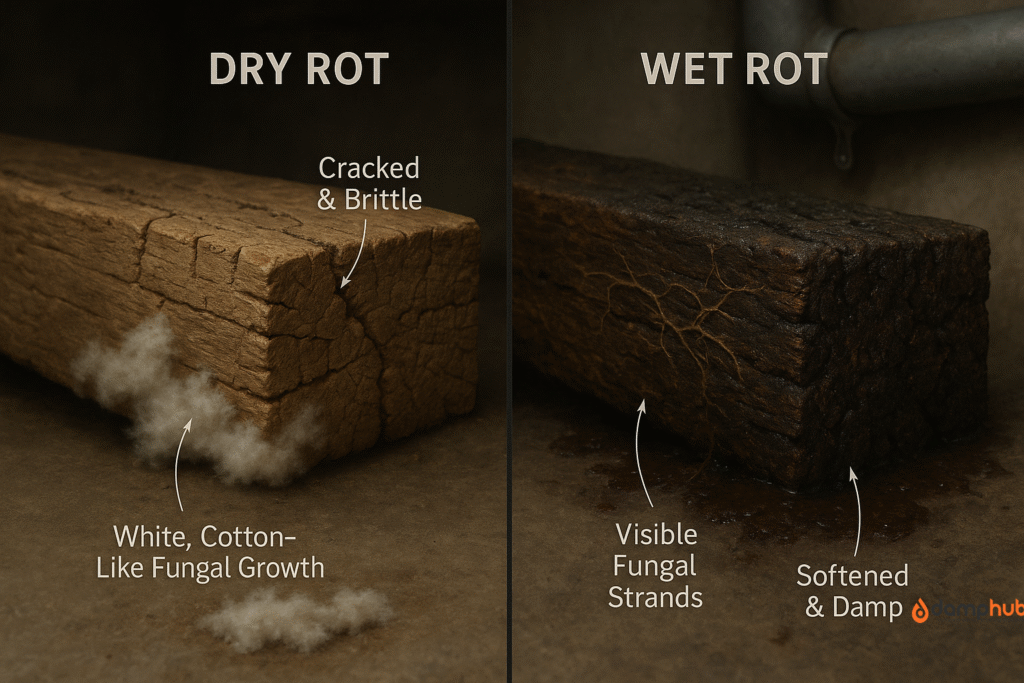
If you’re dealing with rot, neither is great news. But dry rot is usually the bigger problem.
That’s because dry rot spreads. It can move through timber and even travel across brickwork to reach other areas of your home. And unlike wet rot, it doesn’t need much moisture to keep going. Once it’s in, it can quietly grow in places that seem dry on the surface.
Wet rot tends to stay where it starts. It only affects timber that stays damp, like a leaky windowsill or a floor joist above wet ground. It’s still damaging, but it doesn’t travel.
💡 Pro Tip
- ✓ Not sure which one you’re dealing with? Get it checked quickly. Dry rot can be much more expensive to fix if it’s allowed to spread.
Final Thoughts
Dry rot is sneaky. It starts small, spreads fast, and thrives in homes that don’t seem that damp on the surface.
The real trick is knowing what to look for; those early dry rot symptoms like flaky paint, springy floors, or that sweetish mouldy smell. If you spot it early, it’s manageable. Leave it too long, and you’re into costly repairs and timber replacement.
So don’t ignore those strange changes in your home. A quick check could save you thousands — and your floorboards.
Questions People Ask About Dry Rot Symptoms

-
What can be mistaken for dry rot?
Wet rot, mould, or insect damage are the most common lookalikes. Crumbling wood or damp patches can appear similar, but dry rot spreads further and creates distinct spore dust, mycelium (white strands), or fruiting bodies.
-
How to tell the difference between termites and dry rot?
Termites leave behind mud tunnels and hollow timber with bite marks. Dry rot causes brittle, cracked wood and fungal growth like white threads or mushroom-like lumps, with no insect debris or movement.
-
How to identify dry rot in clothes?
Dry rot in clothes looks like weakened, torn fabric that crumbles when tugged. It usually happens in items stored in damp, poorly ventilated areas — and there may be a musty smell or visible fungal growth.
-
Can you paint over dry rot?
No. Painting over dry rot hides the problem but doesn’t fix it. The fungus will keep growing beneath the surface and can cause serious structural issues if left untreated.
-
How quickly does dry rot develop?
Once conditions are right (moisture, poor airflow, timber), dry rot can start growing within days. In a few weeks, it can spread across wood and even brick to other areas of your home.
-
When to worry about dry rot?
As soon as you suspect it. If you notice brittle wood, a damp earthy smell, spore dust, or unusual growths, get it looked at straight away. Dry rot doesn’t go away on its own; it spreads fast.
-
What is the difference between wood rot and dry rot?
“Wood rot” is a general term. Dry rot is one specific type, and the most aggressive. It spreads through buildings and survives in low moisture. Wet rot is another type, but it stays local to where the timber stays damp.
-
What is the damage of dry rot?
Dry rot eats away at timber, making it soft, cracked, and structurally unsafe. It can weaken joists, floorboards, and roof beams even spread to other materials. Repairs can get expensive if they’re not caught early.
-
How can you tell if it’s dry rot?
If you see brittle, cracked wood, a musty smell, fine orange dust, and white cottony strands or mushroom-like growths, that’s dry rot. Also, if it spreads across plaster or brick, it’s likely a dry rot. Why? Because wet rot usually stays put.
-
Can dry rot go away on its own?
No, dry rot won’t go away without treatment. The fungus stays active as long as moisture and poor airflow remain.
Even if it dries out, it can lie dormant and come back. You need to fix the cause, remove damaged timber, and treat the area properly or it’ll keep spreading.

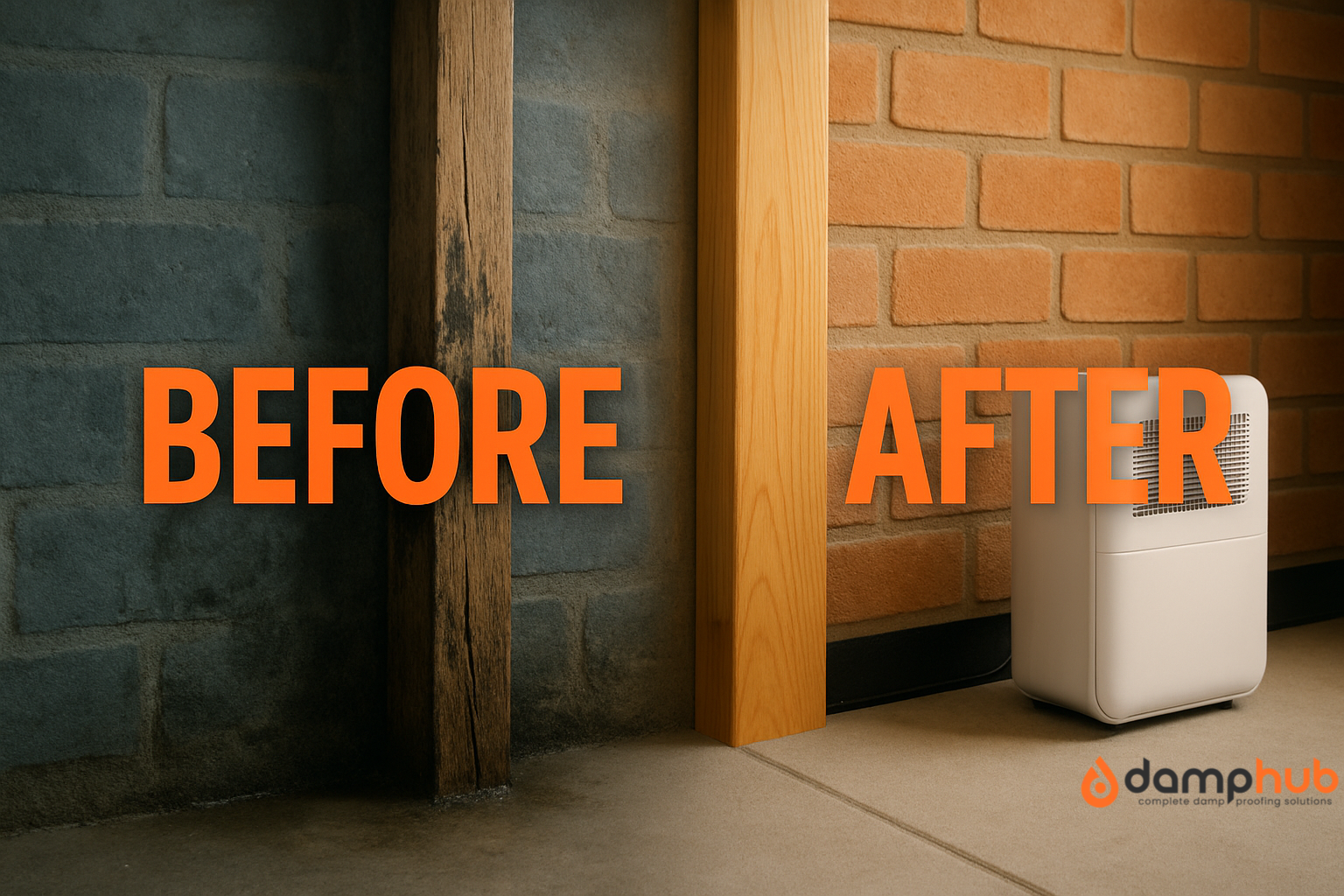
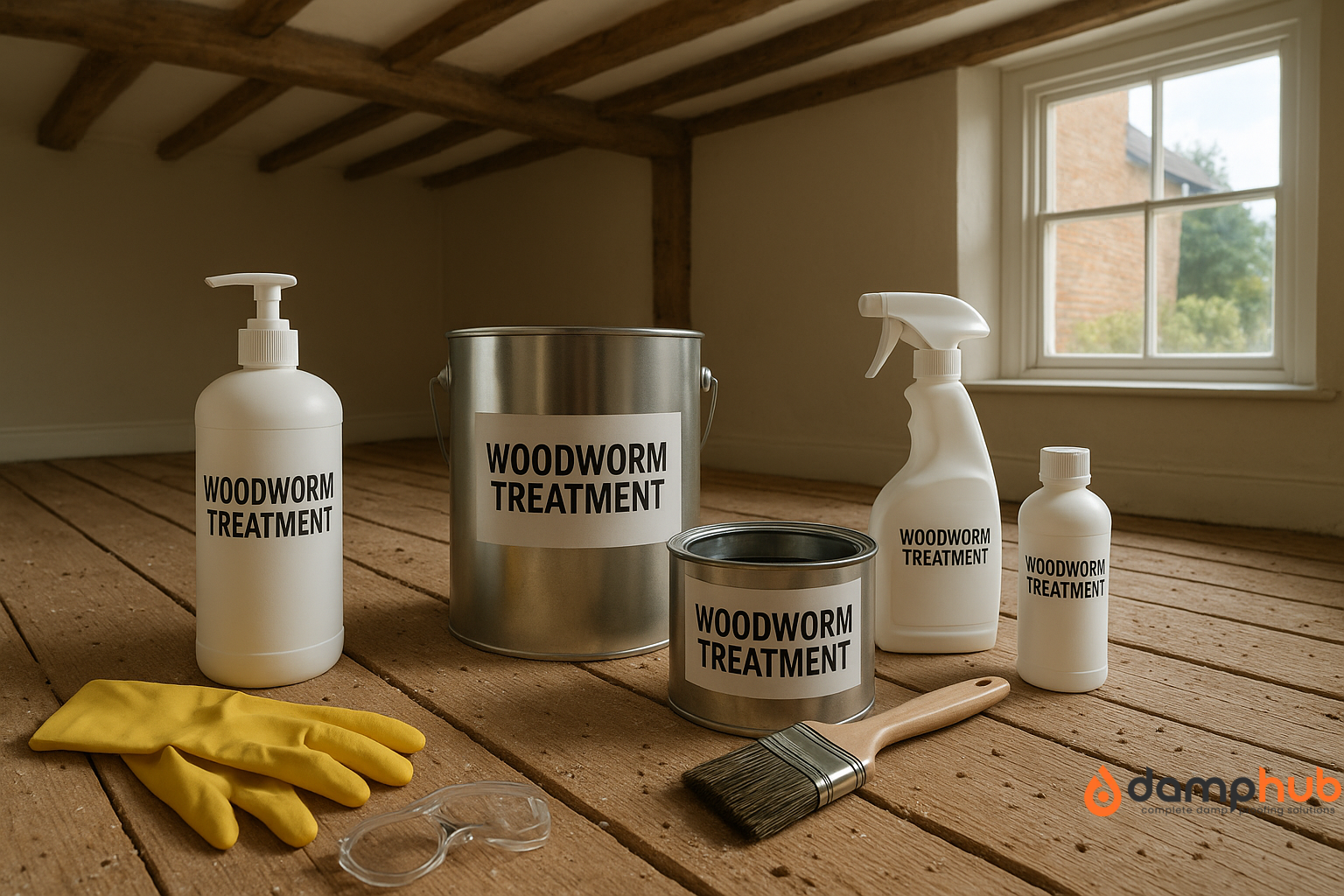

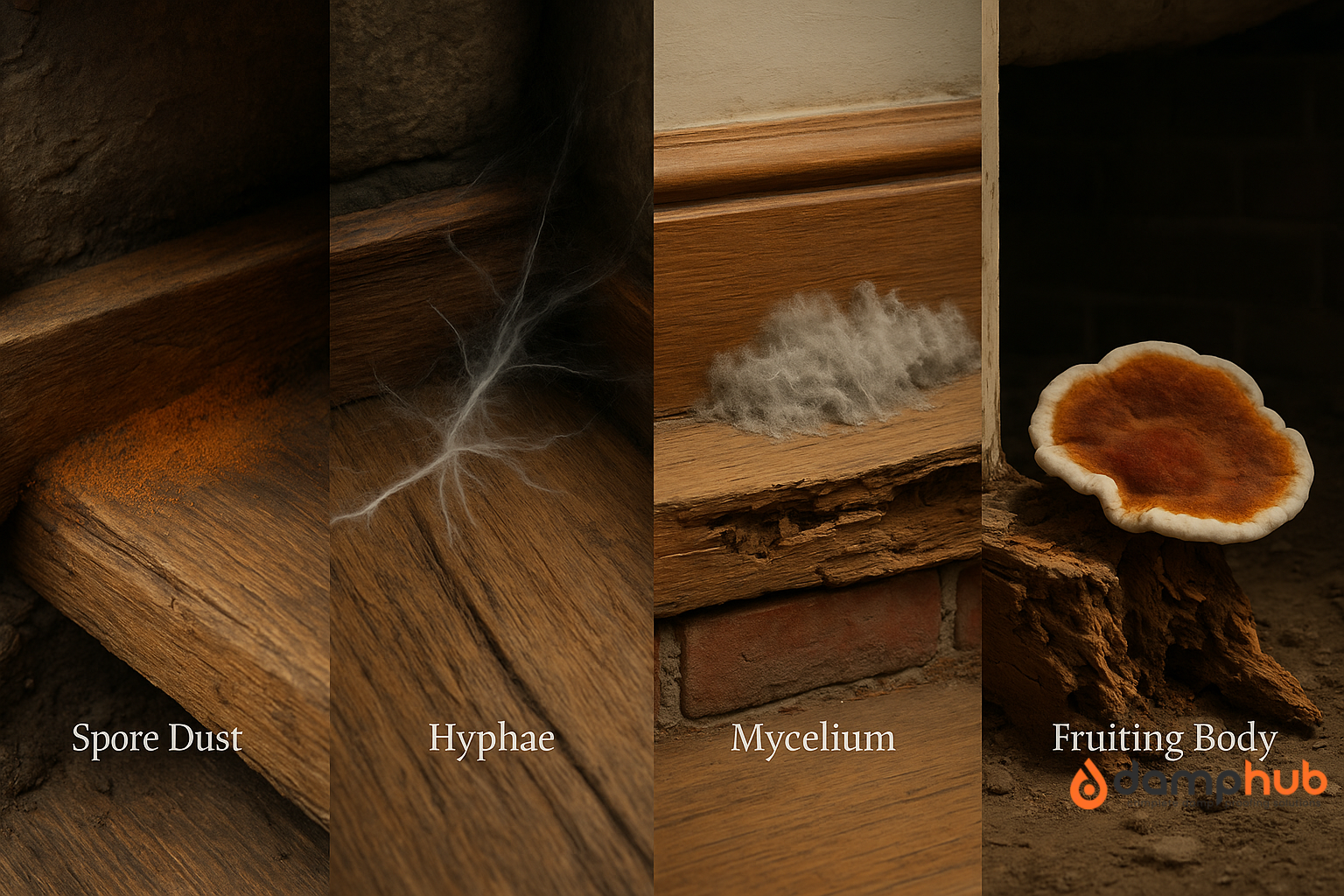
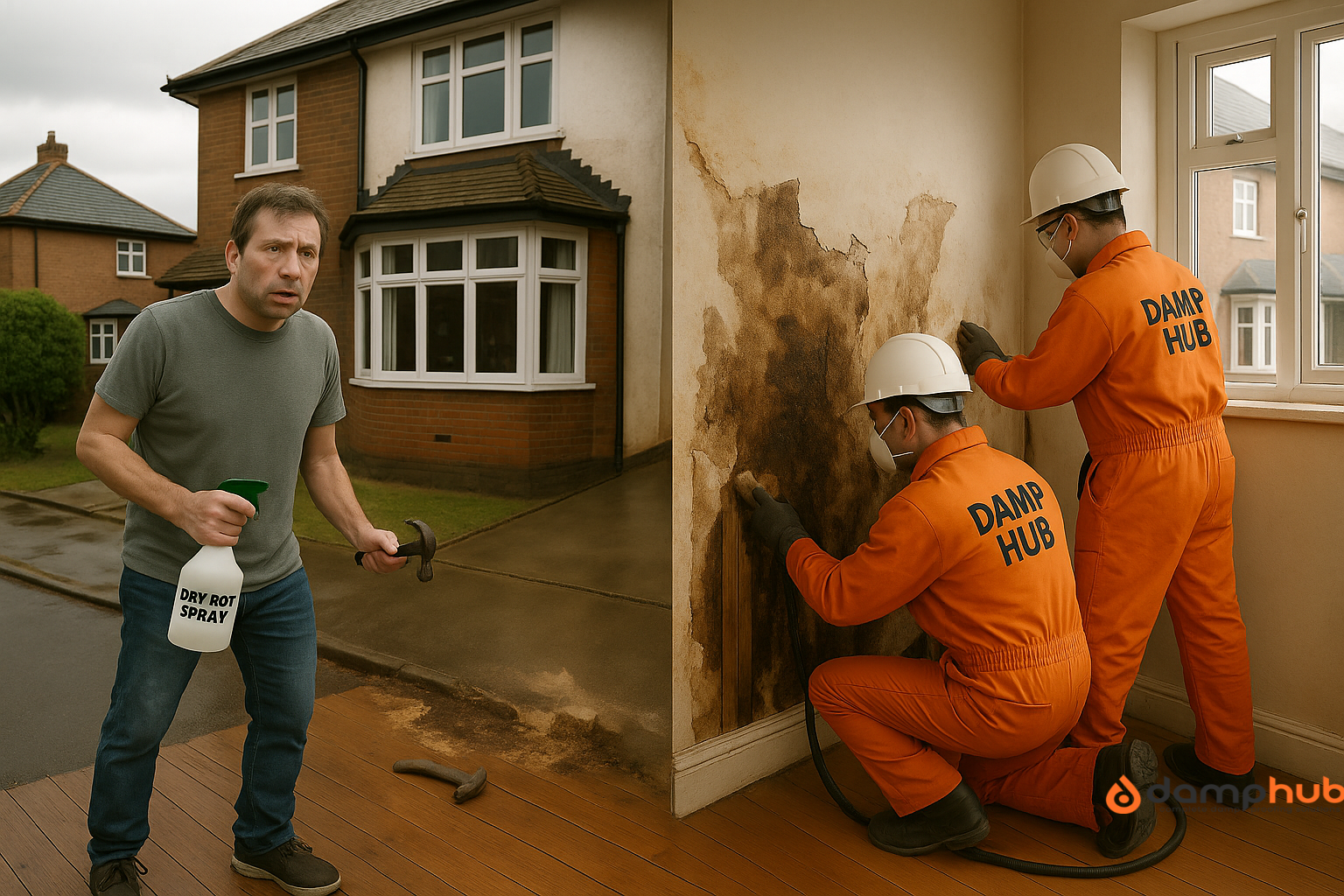
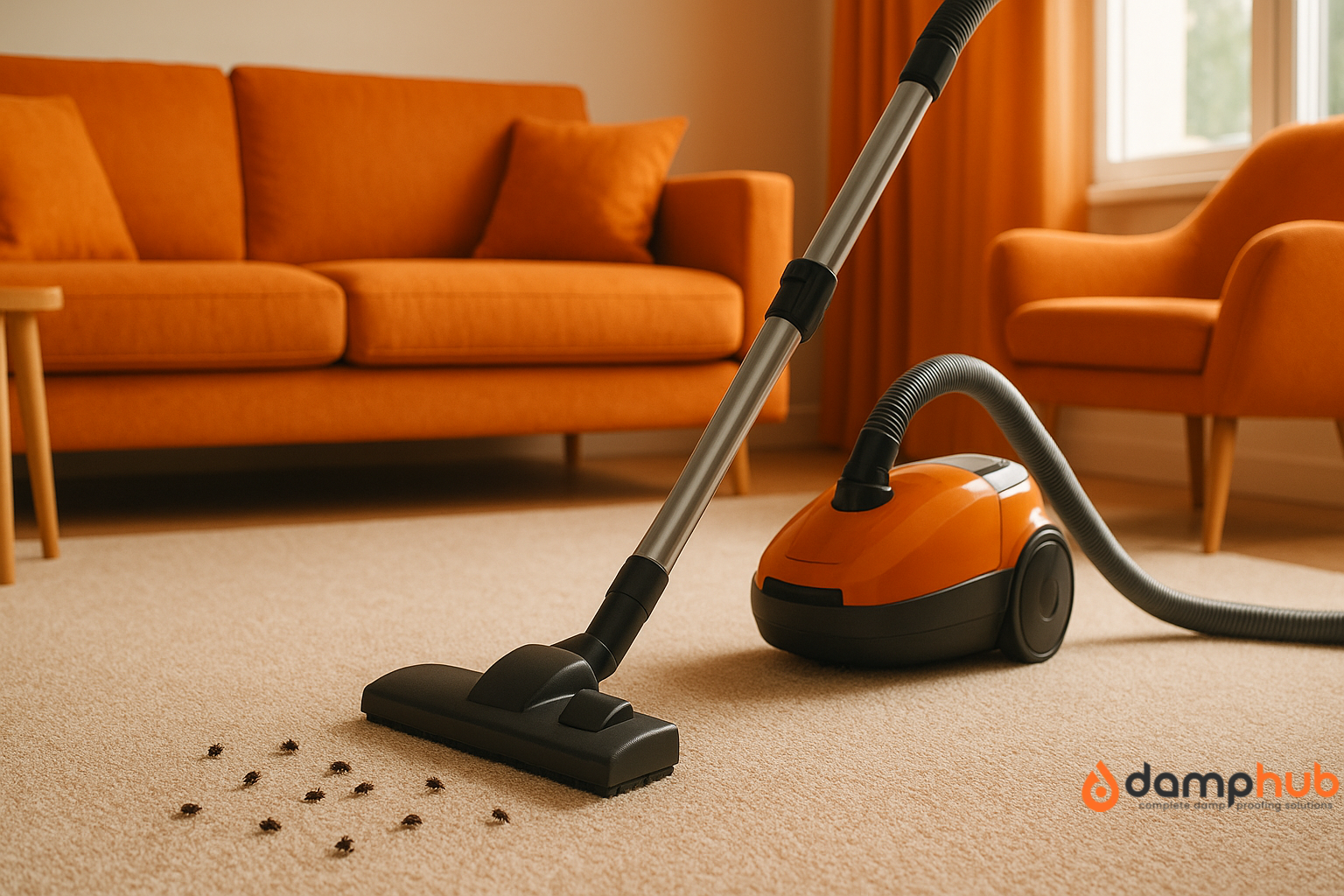
You’ve made some decent points there. I looked on the internet for more
information about the issue and found most people will go along with your views on this site.